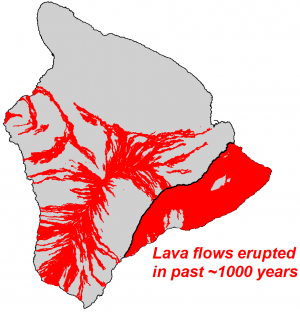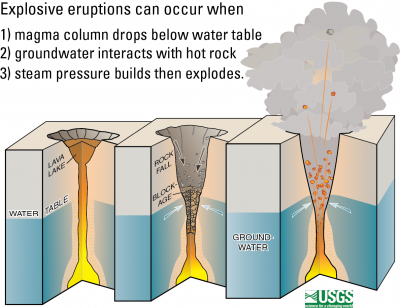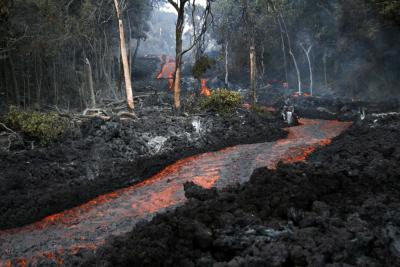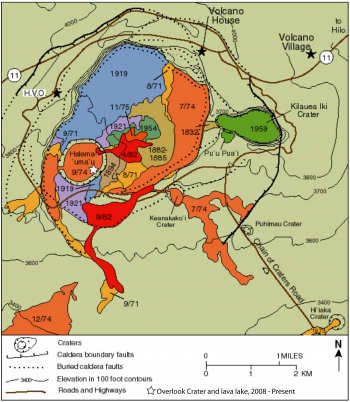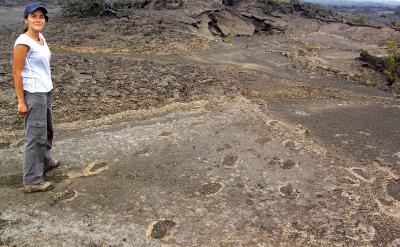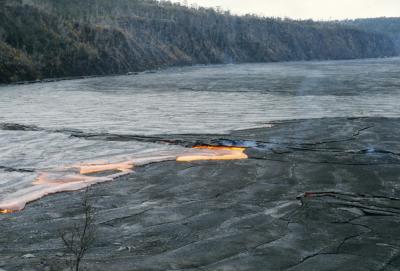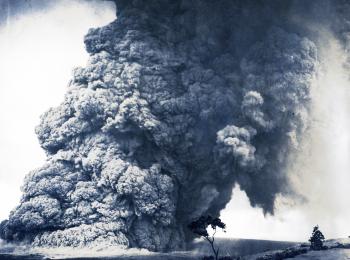USGS: All about Kilauea
May 4th, 2018Kīlauea Volcano is a shield volcano located on the eastern slope of Mauna Loa Volcano on the Island of Hawai‘i. The volcano is considered to be in the shield-building stage of Hawaiian volcanism.
There is a lack of old exposed rock at Kīlauea, which makes it difficult for geologists to piece together its complete eruption history. Only about 10 percent of Kīlauea’s surface consists of rock older than 1,000 years. The other 90 percent of the volcano’s surface is covered by lava flows younger than 1,000 years, and about 20 percent of those flows are less than 200 years old. The Hilina Basalt formation, exposed in Hilina fault scarps on Kīlauea’s central south flank, includes the oldest lava flows found above sea level, which erupted around 50,000 to 70,000 years ago.
Older rocks have been recovered from Kīlauea’s submarine slopes and drill cores, providing some clues to the volcano’s origin. Estimates for the age of Kīlauea’s first-erupted lavas continue to evolve as more samples are collected and various dating methods are used. Current research indicates the first alkali-basalt lava flows erupted onto the ocean floor between 210,000 and 280,000 years ago, and the volcano transitioned from its pre-shield to shield-building stage about 155,000 years ago.
Geologic mapping and dating of Kīlauea’s surface tells of cyclic eruption styles
Long periods of explosive (tephra-dominated) and effusive (lava-flow-dominated) activity have alternated at Kīlauea for the past 2,500 years. Scientists infer that the eruption style is determined by the amount of magma being supplied to the volcano. When magma supply is high, the summit caldera fills and feeds voluminous lava flows from summit and rift zone vents. When the magma supply drops, the caldera collapses. When the caldera floor is deep enough to be at or near the water table (about 500 m (1640 ft) deeper than present), water can seep into the vent to trigger steam explosions. Eventually magma supply increases, and effusive eruptions dominate as many lava flows fill the caldera and erupt from the rift zones.
Prolonged periods of explosive eruptions at Kīlauea may require the presence of a caldera to sustain them. Scientists estimate that during Kīlauea’s past 2,500 years a deep caldera has existed about 60 percent of the time, which included two long periods of sporadic violent explosions. One lasted 1,200 years, ending in about 1000 CE; the other lasted 300 years, between about 1500 and 1800 CE.
Caldera collapse 2,200 years ago ushered in 1,200 years of explosive eruptions
Since Kīlauea’s surface is dominantly covered by young deposits, only the eruption record of the past 2,500 years is suitably well-known. Effusive lava flows were the norm until about 2,200 years ago, when the Powers caldera formed—the precursor to the present-day summit caldera. The caldera collapsed to a depth of at least 620 m (2030 ft), where magma and external water interacted to trigger powerful phreatomagmatic (water plus magma) eruptions. Numerous explosive eruptions lasted for a period of about 1,200 years, producing the Uwekahuna tephra. Sometime between 850 and 950 CE, the most powerful explosive eruption known to have occurred from Kīlauea sent rocks weighing 4.4 kg (9.7 lbs) at least 5 km (3 mi) from the summit. Golf ball-sized rocks fell at the coast, 18 km (11 mi) away.
Lava Flows from 1000 to 1500 CE built the Observatory shield and ‘Ailā‘au flow
Lava flows finally began to erupt again about 1,000 years ago, breaking the 1,200-year-long interval dominated by explosive eruptions. Lava completely filled the summit caldera, then overflowed to form a new shield—the Observatory shield—in place of the caldera. Flows spilled into the surrounding forest, which had grown during the previous centuries, and lava also erupted frequently along the volcano’s east and southwest rift zones. Some archaeologists think people first arrived on the island in the beginning half of the 13th century, 200 to 250 years after the Observatory shield started to form.
Construction of the shield ended around the year 1400 CE. Soon after, lava erupted from a vent on the east side of the shield near the present-day Thurston lava tube (Nāhuku). This effusive eruption lasted for about 60 years, the longest-lasting lava flow witnessed by human inhabitants in Hawai‘i. Known as the ‘Ailā‘au flow, it covered much of Kīlauea, from the summit to the coast on the north side of the East Rift Zone, with some lava spilling southward to the modern Keauhou Landing.
Caldera formation marks transition from effusive to explosive phase
The present-day Kīlauea caldera formed by collapse just after the ‘Ailā‘au eruption ended (about 1470 CE) and before the Keanakāko‘i eruptions began (about 1510 CE). The caldera floor dropped to a depth of about 600 m (1970 ft), with diameters of 3.5 km (2.2 mi) by 3 km (1.9 mi), which is estimated to be a collapse volume of 4 to 6 km3 (1 to 1.4 mi3). Traditional Hawaiian chants suggest that Hi‘iaka, a sister of the volcano deity Pele, dug a deep caldera after the ‘Ailā‘au eruption. This oral tradition describes the caldera’s formation by a dramatic collapse of the volcano’s summit area.
So, how did the caldera form? To trigger a collapse, material must be removed from the magma reservoir within the volcano, creating a void into which the overlying rocks fall. The volume of lava erupted during the 60-year ‘Ailā‘au eruption matches the inferred caldera collapse volume. Perhaps incremental collapses occurred as the magma storage region gradually emptied, then eventually led to a final large collapse as described in Hawaiian chants. It is possible that toward the end of the ‘Ailā‘au eruption, the dwindling magma supply failed to replenish the magma storage system, which collapsed as it emptied.
Kīlauea’s most recent explosive period lasted 300 years
Towering lava fountains, likely more than 600 m (2,000 ft) high, roared from Kīlauea caldera just after it formed and began 300 years of explosive eruptions that ended in the early 19th century. During that time, at least four strong explosive eruptions sent tephra high into the jet stream, with ash falling over a broad area east and offshore of the volcano. This eruptive period blanketed the summit area with an 11-m- (35-ft-) thick deposit known as the Keanakāko‘i tephra.
Near the end of this explosive period in 1790, a series of explosive eruptions sent searing pyroclastic surges at least 3.5 km (2.1 mi) down the west side of the summit area. This was the deadliest eruption known from a U.S. volcano (but at the time, it was the Hawaiian Kingdom). Several hundred (and perhaps more than a few thousand) people were killed within a few hundred meters of where the Hawaiian Volcano Observatory and the National Park’s Jaggar Museum are located today. The unfortunate victims died as a result of the hot, ash-rich surge that both suffocated and burned them.
Current effusive period has lasted about 200 years, but it will switch back again
Only a few lava flows were erupted during the 300 years of explosive activity, but that changed in 1823, when the volcano reverted to an effusive interval that continues to this day. Since then, Kīlauea’s summit caldera has been slowly filling with lava flows, and, at a depth of 120 m (400 ft) today, much shallower than its past depth of at least 600 m (2000 ft). In addition to summit eruptions, numerous lava fountains and lava flows have issued from vents along the volcano’s southwest and east rift zones.
The first explosive eruption on the volcano since the early 19th century took place in 1924 within Halema‘uma‘u Crater on the floor of Kīlauea’s summit caldera. The eruption occurred days after the active lava lake drained away, with the magma probably intruding into the volcano’s East Rift Zone. For 17 days, rocks, ash, and dust erupted in dramatic clouds rising from the crater. Rocks weighing many tons were hurled as far as a kilometer (0.6 mi) from the crater. There was some subsidence within Halema‘uma‘u, but the caldera did not deepen appreciably. Within two months, lava reappeared in the crater and above the level of the water table, which inhibited additional large steam explosions. Although the period of explosive eruptions was brief and violent, they were small compared to those between 1500 and 1800.
Having pieced together the recent geologic past of Kīlauea, scientists conclude that the volcano will eventually return to a long period of mostly explosive activity, just as it did around 1500 CE. This future explosive period will probably accompany a significant decrease in the magma supply rate and be initiated by collapse of a new caldera to the depth of the water table, which today is about 615 m (2015 ft) below the present high point on the caldera rim. For now, effusive eruptions dominate Kīlauea.



